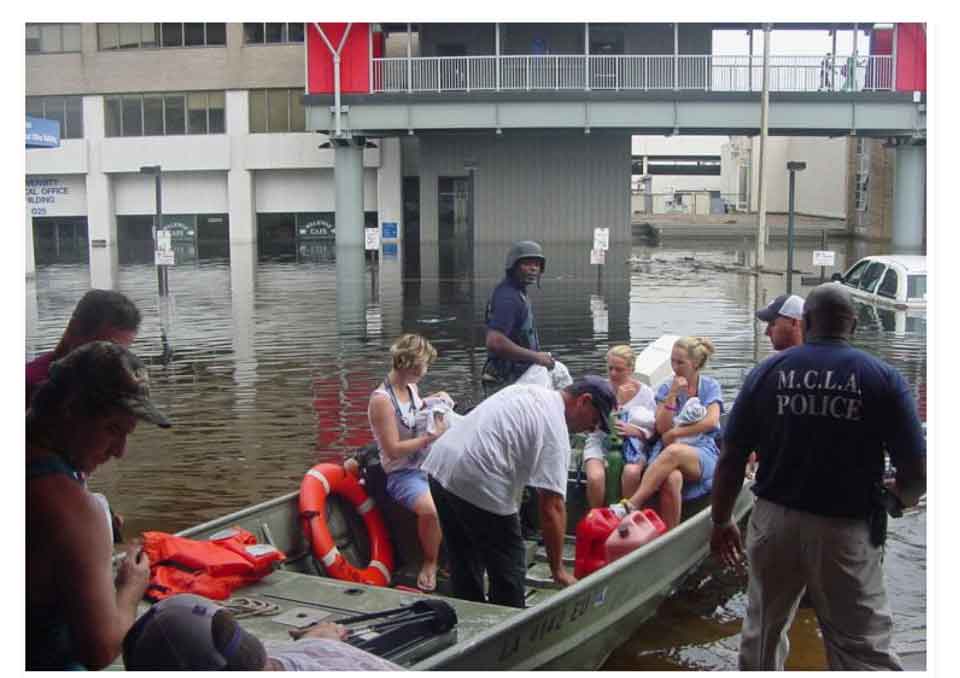This is the eleventh in a series of posts spotlighting recently released email from Governor Tim Kaine’s administration. These posts are not meant to be comprehensive but to encourage further exploration in the Kaine administration records (electronic and paper).
Last week’s post focused on Bill Leighty’s first-hand account of the earliest days of the government’s response to Hurricane Katrina. This post will focus on the experience of Thomas “Tim” Patrick Butcher as shared in an email forwarded to Leighty. Butcher, a registered nurse, was the University Hospital Emergency Preparedness Director for the Medical Center of Louisiana in New Orleans (MCLNO) during Katrina. Flooding stranded Butcher and his staff at University Hospital for five days without power and low supplies.
In a 19 September 2005 email to Health Resources and Services Administration (HRSA) Director of Emergency Preparedness Erin Downey, Butcher thanked Downey for her assistance. “There were some glitches in how things played out after landfall (to put it MILDLY),” Butcher wrote, “but all of our staff got out along with patients on [F]riday after the storm. I hope to be at as many of the after action meetings (assuming they will let me in, ha ha….for at a number of higher levels, those charged with making decisions failed miserably in their responsibilities to do so).”
Butcher also corrected many false stories circulating in the media about what happened at University and Charity Hospitals. “No one robbed our pharmacy at [C]harity, there were no ravenous rats in the stairwells,” Butcher wrote. “There was a loss of water, sewer, a/c, and most of our backup emergency power. But thanks to a grant from the City of New Orleans, we had 15 small generators and also oxygen powered ventilators that kept some of the icu/nicu [sic] patients alive until we could get them out.”
Butcher took many photographs and shared some of his favorites. This picture (above)
“is taken as the staff carried out an infant up to the roof at University hospital on that last day ([F]riday) to be loaded on one of the military Hueys that were landing on the roof. The word quickly spread that the helicopters were landing, and every employee and family member immediately reported to the patient care areas to move the patients up to the roof as fast as the Hueys could be loaded. After the patients had left, they lined up and waited patiently to board the boats. Not one person whined, complained, or tried to move ahead in line as they waited.”
Butcher photographed some of the infants being evacuated by boat earlier in the week. “MCLNO Police Sergeant Marshal Pierre, head of our Emergency Response Team, is there providing protection for them with a full auto M-16. I am making some T-Shirts with this picture and the caption: ‘MCLNO – Better patient care thru superior firepower.’” The final photograph was taken from the last boat leaving University Hospital.
“I am so proud of our staff,” Butcher emailed. “They were stressed, and worried, but every single one of them put the patients above themselves through out.” Butcher’s own home was completely flooded.
Butcher ended his email with his favorite confirmed event from the hurricane.
“One of the ED staff was paddling a flat boat through the neighborhood. She pulled one man out of the water, and started paddling back to the ED. He jumped out of the boat and started to swim away. She hollered, ‘What are you doing?!’ To which he replied, ‘Lady, they’re not gonna let me sell crack in that hospital!’”
After Katrina, Butcher took a position at the University Medical Center (UMC) in Lafayette, Louisiana. He spoke and wrote about his Katrina experiences. Butcher’s work was recognized by UMC and the National Emergency Nursing Association. Butcher died on 9 January 2008 at the age of 53.
The Library of Virginia’s Kaine Email Project makes the email records from the administration of Governor Timothy M. Kaine, Virginia’s 70th governor (2006–2010), accessible online. Users can search and view email records from the Governor’s Office and his cabinet secretaries; learn about other public records from the Kaine Administration; go behind the scenes to see how the Library of Virginia made the email records available; and read what others are saying about the collection. Previous posts spotlighted personal stories, transportation, the state budget and the Kaine records officers. This project would not have been possible without funding provided by Congress for the Library Services and Technology Act (LSTA).
-Roger Christman, Senior State Records Archivists












